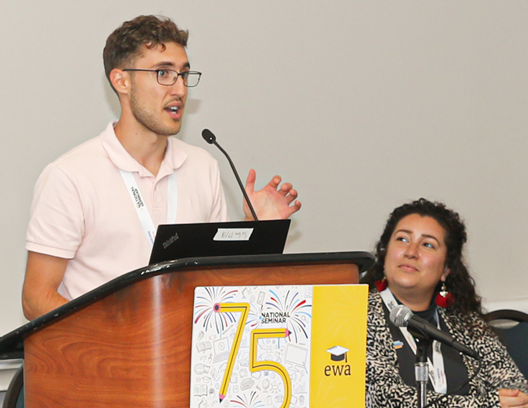Pandemic-relief funding helped develop a new initiative to boost quality summer and after-school learning programs.
Four leaders involved in out-of-school organizations told journalists what a quality program looks like and what to watch for after the Engage Every Student Initiative began rolling out in July. The federal government partnered with five private organizations to give students access to “high-quality, out-of-school time programs” as part of the initiative.
The 74’s Staff Writer Asher Lehrer-Small moderated the July 24 discussion between these after-school program experts and reporters at the Education Writers Association’s 75th National Seminar in Orlando.
“The time after school is the time when students can love learning,” Lehrer-Small said.
Engage Every Student Initiative: What to Know
After-school programs are not accessible for many, noted Jen Rinehart, senior vice president of strategy and programs at the nonprofit Afterschool Alliance.
About 25 million kids would attend if enough programs existed, she said. For the ones that do exist, it’s too costly, and kids lack transportation to get there. Low-income families are the ones who are missing out, Rinehart added.
The American Rescue Plan, however, could change that. Rinehart said the legislation, which provides financial relief in response to the pandemic, is a great opportunity to fund summer and after-school learning. But added only 1 in 5 of those programs have been able to access those funds.
Funds from the plan created the U.S. Department of Education’s Engage Every Student Initiative, which includes partnerships with AASA | the School Superintendents Association; the Afterschool Alliance, the National Comprehensive Center, the National League of Cities and the National Summer Learning Association. It was designed to ensure that every student who wants to attend high-quality after-school or summer programs can.
It’s the first time, Rinehart said, after the U.S. Secretary of Education, Miguel Cardona, called for universal access to after-school and summer programs.
“For those of us that have been working in this space, it’s a monumental moment,” Rinehart said.
Rinehart said she isn’t sure when journalists should expect more of a rollout of Engage Every Student because officials are still figuring out the next steps.
But she suspects those steps include Cardona visiting summer learning sites to learn more about them, announcements of funding opportunities and figuring out how to attract both students and staff to the program.
What After-School Organizations Hope to Accomplish
The National Summer Learning Association is one of the five organizations involved in the Engage Every Student Initiative.
Its vice president of programs and systems quality, Brodrick Clarke, said NSLA wants to fight the existing inequality in summer programs. A focus for the nonprofit is to close the opportunity gap between privileged and less-resourced children. It’s not necessarily about catching up on information a student missed during the school year.
“When we’re talking about summer learning, we’re not talking about summer school,” he said.
A September 2009 report by Child Trends, a nonprofit research organization, stated summer learning programs are likely to have positive impacts when they include hands-on and real-world applications. It also suggests effective programs include grade-level curricular standards, experienced teachers and 15 or fewer student class sizes.
NSLA recognized Breakthrough, a national summer learning organization, as one of the best in the nation. That’s according to Gia Maxwell, a site director and director of curriculum and instruction at Breakthrough’s Miami affiliate.
A few factors Breakthrough looks for in scholarship recipients for its program are racial minorities, recipients of free and reduced meals and kids living in a single-parent household. The organization also offers a teaching fellowship. About a third of the scholars become teaching fellows, Maxwell said.
Since the pandemic, Maxwell said staffing has been challenging at the Miami location. She said they are typically fully staffed by the middle of May. The program starts the third week of June. This year, they were only 75% staffed a week before the program started.
However, with the pipeline staff created through the teaching fellow program, past program participants can return to be volunteers and paid interns.
What a Recent Student Says About After-School Programs
Ramaya Thomas provided the perspective of a recent student.
Thomas is a high school graduate, youth ambassador of the Afterschool Alliance, another partner in the Engage Every Student Initiative, and a frequent after-school and summer program attendee.
She said one of the things that create quality after-school programs is representation. Students want to attend programs where they can see themselves, she explained.
Tips for Reporting on After-School Programs and Summer Learning
The four after-school program experts also offered reporting advice to journalists:
- Talk to more students when covering this subject, Thomas advised. She suggested finding them in the community, in the schools or on social media. “It’s really not that hard to reach us,” she said.
- Identify organizations that are bringing the community together.
- Determine how recipients of federal funds are using it.
- Recognize smaller, Black-owned organizations that are doing this type of work.
- Reach out to organizations with after-school or summer learning programs, such as Breakthrough, Horizons National, Boys and Girls Club, Camp Fiver in New York, and ourBRIDGE for Kids in North Carolina, to name a few.



